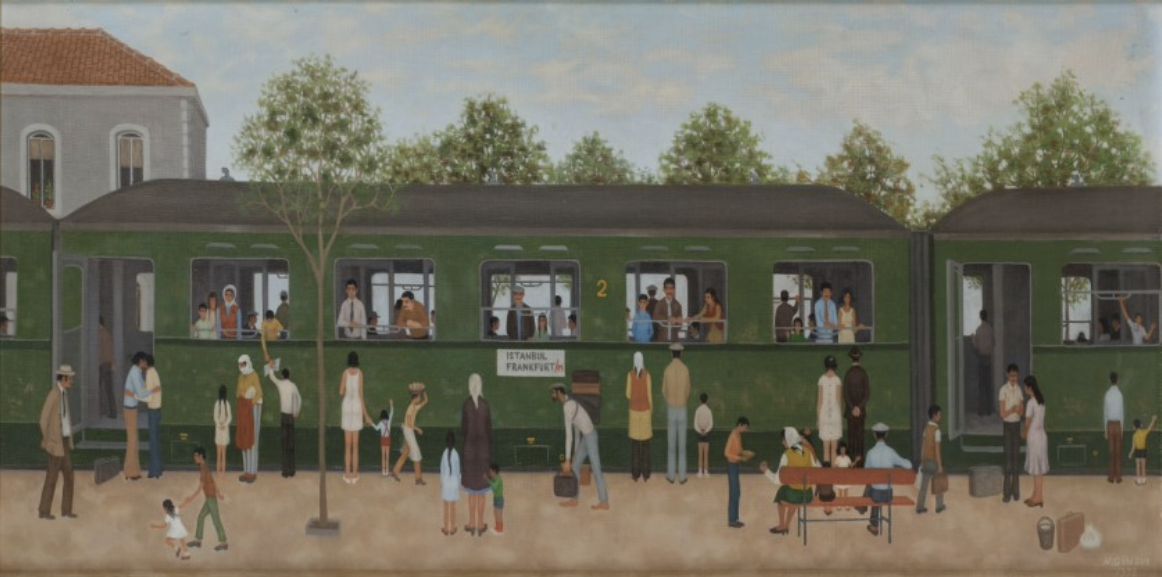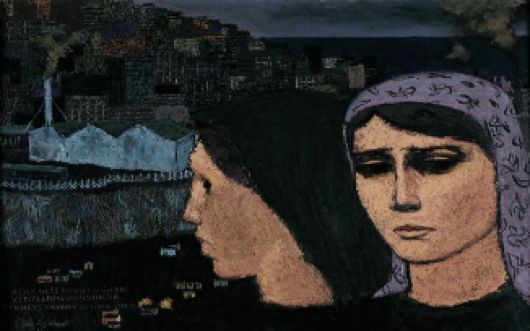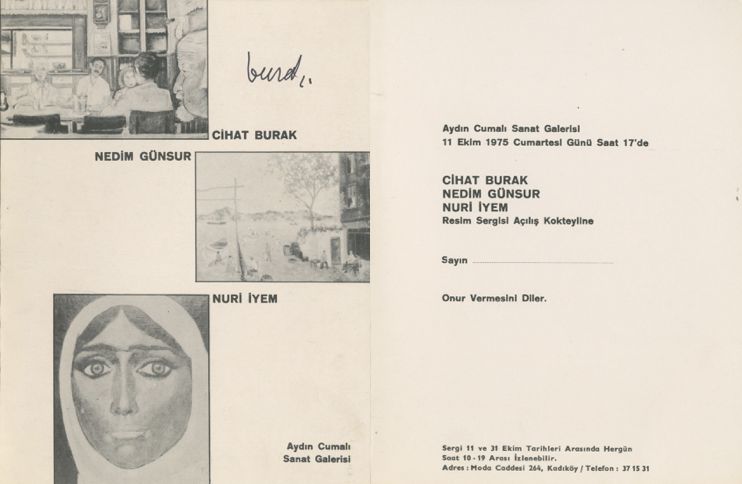The Phenomenon of Migration After 1950 in Turkey and Its Effect on Turkish Painting
Human migration is the change of the place where the person or a group lives permanently. ‘Human migration’ does not include nomadism (seasonal migration), seasonal labor, arbitrary travel. Human migration; what immigrants do to raise their living standards; to escape negativities such as war, hunger, unemployment or political oppression; is compulsory or non-essential mobility. Migration is an ordinary human behavior. Evolutionarily trying to protect and survive is part of human nature.
Migration from Village to City in Turkish Painting
The migration culture, which has existed since the beginning of humanity, is also a very important part of Turkish culture. For the Turks who passed into settled life later than other nations in their time, the concept of nomadism, "expatriate" and the psychological and sociological consequences of this culture; It has been an indispensable part of cultural identity. Although migration movements decline as mass movements for Turkish states (especially after the Seljuk Turks), they will always survive as a result of culture and survival instinct.
Migration movements within the country that were only towards Ankara before the 1950s; II. It is also reflected in cities such as Istanbul and Bursa with the developments after World War II. Marshall Aids and term management; The steps taken in order not to encounter the crises of 1927 again and to structure the country production-oriented trigger these migration movements. Innovations that will facilitate communication and transportation such as roads and radio to villages; It has increased the attractiveness of cities that aim for industrialization. With the reduction of labor by tractors and other agricultural machinery in rural areas, migration has now become inevitable, not only arbitrary, for the village population that does not own land and is unemployed.
However, as the results of the wrong planning and the disproportionate migration of cities, the inability of integrate incoming people into the identity and structure of cities, unemployment and lack of housing; economic and class differences emerged between cities and even different neighborhoods. These differences caused the formation of slum structure, arabesque culture and other social, political and artistic movements. At the same time, the psychological and sociological aspects of migration and the currents it creates affected politics, economy and culture, as well as art.
Contemporary Turkish painting as an art influenced by migration from village to city and formation; It aims to reflect the feelings such as trauma, poverty and desperation brought by migration and to create a dialogue around these feelings. Artists who focused on this subject especially in the 50-60s; maybe they have a great foresight that; they were able to portray the problems created by unplanned and disproportionate migration movements in their works.
Choosing folk culture and social events as a subject (representing social-realism); the "Yeniler (The New Ones)” group (1940-1952) founded by Léopold Lévy's students and the "Onlar (Them)” group (1947-1955), founded by Bedri Rahmi Eyüboğlu's students in 1947, are especially prominent formations in these representations.
Nedim Günsür, a member of the them group, has the chance to study in France with a scholarship he received in the years approaching the 50s. Meanwhile, he works in Lhote and Léger's studios and encounters the works of Picasso and Matisse. In addition to Western works, he is also familiar with works of art from Africa. It is also influenced by the local and unique language of expression of African art. Considering that Eyüboğlu is also a student, a descriptive and descriptive narrative emerges in his works.

Nedim Günsür, “Yeşil Tren/Istanbul-Frankfurt”, 1978, Nilüfer-Önal Akalın Collection.
Nuri İyem, who is from the Yeniler group, also talks about people and women who are under the influence of slums and migration in her works. Anatolian women are known for their portraits and frequently talked about the effect of the slum lifestyle on women. İyem, who had a more abstract understanding before focusing on these issues; in the 1960s, gained a more concrete and realistic perspective with the effect of the subject. Pictorial architecture and construction are also very visible in İyem's slum paintings and other works.

Nuri İyem, “Açar Gecekondu Gülleri Kentler”, 1978, oil on duralite, 44X36.5 cm.
Referring to the subject of migration and slum culture, Günsür, İyem and other artists will also consider the migrations to Europe, which will be experienced later, as a subject; they will touch on concepts such as foreignness, class inequality and expatriate created by migration.

Resim Sergisi, Aydın Cumalı Sanat Galerisi, İstanbul, 11 Ekim 1975. Salt Research Archive
Migration, which is one of the most basic behaviors of human beings; not only economic consequences; it also has social and psychological consequences. Especially when more special results such as disproportionate population changes and distorted urbanization emerge, class differences, poverty and cultural chaos grow enough to change the social structure and culture of the migrated place. Migration from village to city in the 1950s; especially in Istanbul, changed the social texture and caused new developments in the country. Adapting to this change and shedding light on problems is the subject of painting as well as the subject of every field. Turkish artists also deal with the subject of "migrance", which is already a part of Turkish culture, in the focus of a new and industrialized city. Meanwhile, they break away from abstraction and determine a more realistic understanding and document history in a sense.
Çelebi Erol, Cansu. “Göçün Öteki Yüzü, Türkiye Çağdaş Sanatında Göç Olgusu”. ulakbilge, 47 (2020 Mart): s. 400–407. DOI: 10.7816/ulakbilge-08-47-02.
Kaymal, C. (2017). “Kırdan Kente Göçün Sosyokültürel Sonuçları: Gecekondulaşma ve Arabesk”. ulakbilge, 15, (2017): s.1499-1519. DOI: 10.7816/ulakbilge-05-15-07.
Çalışkan, Serkan. “Çağdaş Sanat Eserlerine Göç Olgusu Perspektifiyle Bir Bakış”. İdil Dergisi, 41 (2018): s.39-45. DOI: 10.7816 /idil-07-41-06
Güngör, Tuğba. “Çağdaş Türk Resim Sanatında Göç Olgusu: Mehmet Başbuğ Özelinde Bakmak”. MANAS Sosyal Araştırmalar Dergisi, 3, (2020): s. 1608-1626. ISSN: 1694-7215.
Tilbe, A., Bosnalı, S., & Küçükşen Öner, F. (2016). “Bölüm 4: Çağdaş Türk Resim Sanatında Göç Teması: Ramiz Aydın Örneği”. *Göç Üzerine Yazın ve Kültür İncelemeleri* (s. 41–54), Transnational Press.
Encyclopædia Britannica. *Human migration*. Encyclopædia Britannica. https://www.britannica.com/topic/human-migration.
Dünden Yarına Nuri İyem 2, Nuri İyem Resimleri Arşiv ve Belgeleme Projesi Retrospektif Sergisi, Çağının Tanığı Bir Ressam-Nuri İyem: Göç Resimleri, Evin Sanat Galerisi, İstanbul: 2007: http://www.nuriiyem.com/wp-content/uploads/nuriiyem_2002_cilt2.pdf

